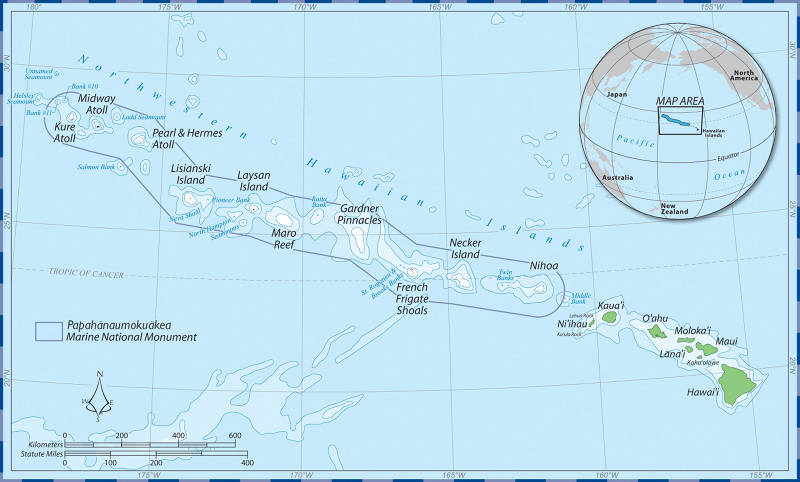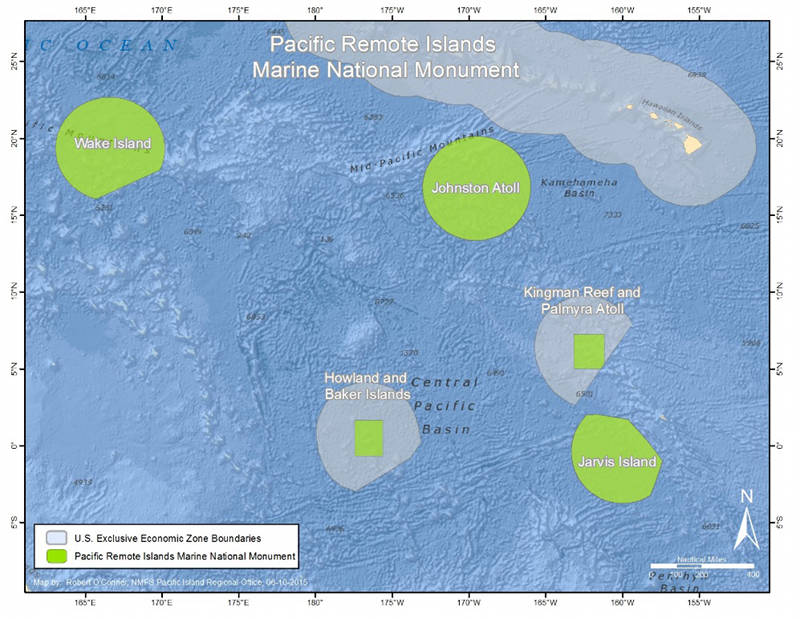
By Daniel Wagner - Research Specialist, NOAA Papahānaumokuākea Marine National Monument
In the summer of 2015, NOAA Ship Okeanos Explorer will be conducting mapping and remotely operated vehicle operations in the two largest Monuments of the United States: the Papahānaumokuākea Marine National Monument and the Pacific Remote Islands Marine National Monument, now known as Pacific Islands Heritage Marine National Monument. These two sites are amongst the largest and most remote marine protected areas (MPAs) on the globe, and as a result are home to a myriad of fascinating biological, geological, and cultural features.

A map of the Hawaiian Archipelago showing the location of Papahānaumokuākea Marine National Monument in the Northwestern Hawaiian Islands (blue outlined area). Image courtesy of the NOAA-ONMS-PMNM. Download larger version (jpg, 629 KB).
Located in the Northwestern Hawaiian Islands, Papahānaumokuākea Marine National Monument (PMNM) encompasses a series of islands, atolls, submerged banks, seamounts, and open-water ecosystems that span 362,061 square kilometers. With a spectrum of elevations ranging from abyssal depths greater than 5,000 meters below sea level, to rugged island hillslopes up to 275 meters above sea level, PMNM harbors diverse habitats including pelagic basins, abyssal plains, submarine escarpments, coral reefs, shallow lagoons, littoral shores, dunes, and dry coastal grasslands.
Due to their vast geographic isolation, PMNM’s ecosystems have remained largely protected from many of the human stressors that impact more populated areas and are among the most pristine in the world.
The marine habitats of PMNM are home to more than 7,000 species, 25 percent of which are endemic to the region, meaning they are found nowhere else on the planet. At the northernmost atolls of the Monument, over 50 percent of the reef fish populations are composed of endemic species, signifying that PMNM represents one of the major reservoirs of marine biodiversity on the planet.
The Monument is home to 19 threatened or endangered species, including the endangered Hawaiian monk seal. It also provides nesting grounds for over 90 percent of Hawaii’s threatened green sea turtles and 14 million seabirds. More than 99 percent of the world’s Laysan albatrosses and 98 percent of black-footed albatrosses return to PMNM to reproduce each year.
These are just a few of PMNM’s land-based and shallow-water natural features. However, as more than 98 percent of PMNM’s seafloor lies below 100 meters, its deep-water resources are far less known than its shallow-water counterparts. These deep areas likely include many secrets yet to be discovered. A single deep-water expedition to the Monument in 2003 discovered more than 20 new species of corals and sponges.
The geology of PMNM is equally fascinating. Formed by the Hawaiian hotspot millions of years ago, the islands traveled northwestward along the Pacific tectonic plate, slowly subsiding to become what they are today. This geological progression continues beyond the last emergent island, Kure Atoll, as a chain of submerged platforms that makes a sudden northward bend to become the Emperor Seamounts, which extend across the entire North Pacific to Russia. These volcanic platforms terraced with drowned fossil reefs provide a detailed record of the formation of the Hawaiian Archipelago.
Papahānaumokuākea has great cultural significance. Early Polynesian voyagers arrived in the Northwestern Hawaiian Islands as early as 1000 A.D., with periodic settlements occurring for over 700 years on the islands of Nihoa and Mokumanamana. These two islands have more than 140 identified archaeological sites, the highest density of prehistoric structural remains in the entire Hawaiian Archipelago. As a result, both Nihoa and Mokumanamana are listed on the National and State Registers of Historic Places. Native Hawaiians maintain a cultural connection to the place through traditional navigation, natural observations, and cultural practices.
The Monument is also home to a variety of post-Western-contact historic resources, including several legendary 19th-century commercial whaling ships, as well as aircraft and vessels from World War II, many associated with the historic Battle of Midway.
Due to its extensive and unique resources, the region has undergone a long history of protection, beginning in 1903 when President Theodore Roosevelt sent in the U.S. Marines to stop the slaughter of seabirds for feathers and eggs at Midway Atoll. Over the next 100 years, six U.S. Presidents and one Hawai'i Governor afforded the region increasing protection, including the establishment of the Hawaiian Islands Reservation in 1909, the Hawaiian Islands National Wildlife Refuge in 1940, the Midway Atoll National Wildlife Refuge in 1988, the Northwestern Hawaiian Islands Coral Reef Ecosystem Reserve in 2000, the Northwestern Hawaiian Islands State Marine Refuge in 2005, and PMNM in 2006.
Culminating this long history of designations, Papahānaumokuākea was globally distinguished through World Heritage inscription in 2010 as the first (and still only) mixed World Heritage Site (for both natural and cultural value) in the United States, sharing this special status with only 30 other sites in the world.
For more information, visit www.papahanaumokuakea.gov .

Map showing the location of the PRIMNM. Image courtesy of the NOAA Office of Ocean Exploration and Research, 2015 Hohonu Moana. Download larger version (jpg, 497 KB).
The Pacific Remote Islands Marine National Monument (PRIMNM) consists of Wake, Howland, Baker, and Jarvis Islands; Johnston Atoll; Kingman Reef; and Palmyra Atoll. These islands and atolls are spread across the Pacific and represent the most widespread collection of marine and terrestrial protected areas on the planet under a single country’s jurisdiction.
Designated in 2009 by President George W. Bush and expanded in 2014 by President Barack Obama, the Monument now protects an area of over 1,269,000 square kilometers. The islands and atolls themselves are tiny specks of land in this sea of blue, with land areas reaching only 6.5 square kilometers at the largest (Wake) and a maximum elevation of 8 meters (Baker).
This area sustains a diversity of species including corals, fish, shellfish, marine mammals, seabirds, land birds, insects, and vegetation not found anywhere else in the world. Many threatened, endangered, and depleted species thrive in the Pacific Remote Islands, including the green and hawksbill turtle, pearl oyster, giant clams, reef sharks, coconut crabs, groupers, the humphead and Napoleon wrasse, bumphead parrotfish, dolphins, and whales.
Both Palmyra Atoll and Kingman Reef support higher levels of coral diversity (180-190 species) than any other atoll or reef island in the central Pacific. The waters surrounding Baker, Howland, and Jarvis Islands have abundant fish biomass due to the Equatorial Undercurrent that moves from west to east along the equator, creating localized, nutrient-rich upwelling in the shallows adjacent to the islands.
The PRIMNM also contains some of the oldest islands and atolls on the planet and is estimated to contain hundreds of seamounts, which are valuable habitat for deep-sea corals, as well as pelagic species.
In 2015, Okeanos Explorer will visit Johnston Atoll in the PRIMNM. Operations will be focused on the Horizon Tablemount, the Karin and Johnston Seamount Chains, and areas offshore of Johnston Atoll.
Johnston Atoll is regarded as a key stepping stone for a number of central and south Pacific marine species to colonize the Northwestern Hawaiian Islands. For example, table coral (Acropora cytherea) is common throughout the tropical Pacific and at Johnston, but in Hawaii, its distribution is limited to French Frigate Shoals and neighboring atolls. French Frigate Shoals in PMNM is the closest point in the Hawaiian Archipelago to Johnston, which is only 500 miles to the southwest. Johnston Atoll has been identified as a stepping stone for colonization of the Hawaiian Archipelago, but conversely may also represent the furthest outpost for some species common in Hawaii.
First identified by a whaling ship in the late 1700s, Johnston Atoll was designated as a federal bird refuge in 1926. The atoll was placed under U.S. Navy control by President Roosevelt in 1934, but retained its status as a refuge. Throughout World War II, Johnston served as a strategic military site, famous for testing of atomic weapons and storage of dangerous chemicals. The atoll is still managed by the U.S. Air Force, but will be returned to the U.S. Fish and Wildlife Service for management as a refuge.
The atoll itself is estimated to be about 85 million years old. Within the Monument area (which encompasses the U.S. Exclusive Economic Zone at Johnston), mineral resources such as manganese crusts containing rare earth elements, as well as nickel, cobalt, and platinum, have been found.
Like many of the Pacific Remote Islands, there is limited information available on the deep-water environments surrounding Johnston Atoll. Explorations in 2015 will provide increased, high-resolution bathymetric information, as well as first looks at unstudied seamount communities.
The data collected during the 2015 expeditions to these two Monuments will greatly improve our understanding of the unique biology and geology of the region. Due to the vast remoteness of these two Monuments, they contain some of the most pristine ecosystems on the globe, including extensive deep-water habitats, which have remained largely unexplored. As a result, the upcoming Okeanos Explorer expeditions represent an enormous opportunity for scientific research, which will undoubtedly lead to new discoveries in a system that is largely undisturbed from human perturbations.